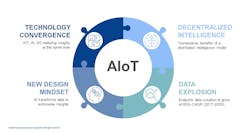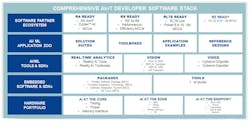The Convergence of AI and IoT Needs a Multi-Layered Ecosystem
This article is part of the TechXchange: The Internet of Things (IoT).
What you’ll learn:
- The transition of computational capacity from centralized to decentralized architecture.
- Driving intelligence from the cloud to the edge and endpoint
Over the last decade, as connected devices proliferated and their capabilities expanded, there grew a need for real-time decision-making independent of the cloud or connectivity. The move to a distributed architecture, driven by the transition of computational capacity from the cloud to the edge, ushered in a new era of edge computing (Fig. 1).
Edge computing has several fundamental advantages, including varied connectivity and data mobility options, the ability for real-time decision-making, localized compute power, and dynamic storage and security capabilities. We see those benefits increasingly reflected across a broad spectrum of applications, such as autonomous driving, logistics, and factory automation, to name just a few.
IoT Device Data: From 80 Zbytes to Dark Data
Data created by IoT endpoint devices is expected to grow at a staggering 85% with total data generated by IoT devices to reach roughly 80 zettabytes in 2025 (IDC, Future of Industry Ecosystems: Shared Data and Insights). For context, zetta has 21 zeroes! Taking this a step further, approximately 90% of all data collected by enterprises today will never be used and is considered “Dark Data.” The bottom line is that data is data until we do something with it. And this is where artificial intelligence/machine learning (AI/ML) becomes so powerful and meaningful.
Artificial Intelligence of Things (AIoT) is a megatrend, driven by an alignment of multiple underlying trends. The first is that three powerful technologies (IoT, AI, and 5G) are maturing at roughly the same time, with a shift to a decentralized intelligence model from the traditional cloud-centric model.
To truly enable intelligence at the extreme edge and endpoints in the network, it must be done in a way that’s highly efficient, responsive in real-time, and cost-effective. What this means is running cloud-independent inference engines on tiny computers within endpoints. A decentralized intelligence model has tremendous technical and economic benefits.
Second, there must be a heightened awareness of the importance of AI in the engineering community. AI is fundamentally transforming design methodologies and system-level approaches. Core technologies like cybersecurity and human-machine interfaces can tremendously benefit from the problem-solving capabilities of AI and ML. And, finally, the power in the tremendous amount of data generated by IoT endpoints can only be harnessed to its full potential through AI/ML.
Intelligence in the Cloud
This trend of driving intelligence from the cloud to the edge and endpoint will become increasingly common. Any rapid technology transformation comes with its challenges, and this is no different. While AI will drive tremendous growth in semiconductors, a deep technology stack including software, solutions, and tools is critical to enable success.
Active participation in, and enablement of, ecosystems and end-to-end solutions for specific industries or “micro-verticals” will ensure that success. To reach this goal, however, streamlining developer experience and developer complexity will be critical.
For example, Renesas strives to build a comprehensive hardware/software stack for developers. The foundation is the company’s strong hardware portfolio coupled with intuitive and flexible software development kits (SDKs) for embedded developers (Fig. 2). This stack leverages its software partner ecosystem, AI and ML application tools, embedded software, and the hardware involved.
As AI has started to gain momentum, Renesas has made a concerted effort over the last couple years to bring the embedded and AI developer domains closer. On the real-time analytics front, there’s an auto-ML tool that was obtained through the acquisition of Reality AI. The company continues to enhance this toolchain, and it’s now context-aware and interoperable with the popular embedded Eclipse-based IDE e2Studio.
In addition, Renesas continues to build toolboxes that are domain-specific extensions to the base tools platform. Examples of this include RealityCheck Motor and RealityCheck AD for applications within the domains of motor control and anomaly detection, respectively.
On the Vision front, an SDK for the RZ/V product line enables customers to bring their own models or pick from an extensive library of pre-trained applications with the flexibility to work across a broad range of popular open-source frameworks. Furthermore, tools are available for developers to run deep-learning models for vision on general-purpose MPUs and MCUs. Voice is another exciting area, with fantastic partners, enabling the bundling of these state-of-the-art tools with Renesas products, offered to customers license-free.
Renesas continues to build a broad variety of applications with solutions like the RealityCheck HVAC suite. These include hardware/software and services or a library of toolchain extensions and application examples for customers to get a head start with their designs. There’s also the Renesas Ready Partner Network ecosystem that has 300+ commercial-grade, building-block solutions suitable for IoT and AIoT development.
It’s an exciting time for technology, for the industry at large and most importantly for builders and developers.
Read more articles in the TechXchange: The Internet of Things (IoT).


